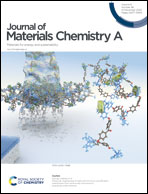Trifunctional modification of individual bacterial cells for magnet-assisted bioanodes with high performance in microbial fuel cells†
Abstract
Surface modification of exoelectrogenic bacteria represents an impressive development in microbial fuel cells (MFCs), because every bacterial cell can maintain an intimate contact with the anodic material for upgrading the performance. Here, Au and Fe3O4 co-modified Shewanella oneidensis MR-1 is developed for the bioanode of MFCs. The co-modified bacterial cells are synthesized by the biomineralization of Au nanoparticles (NPs) and the electrostatic attraction of Fe3O4 NPs to the cell surfaces. The highly conductive Au NPs accelerate electron transfer inside the biofilm and between the biofilm/electrode interfaces. Meanwhile, the bioaffinity of Fe3O4 NPs can help to retain the bacterial metabolic activity for a long time. More importantly, the magnetic activity of Fe3O4 NPs allows the fast capture of co-modified bacteria onto the magnetic substrate electrode, largely improving the bacterial loading amount and decreasing the time for bacterial colonization. As a result of this trifunctional modification, the magnet-assisted bioanode fabricated with co-modified bacteria is far superior to that with native bacteria in start-up, stability and output performance. This work not only deepens the application of cell-surface modification technology in MFCs but also brings bacterial cells into the stage of multi-step modification.

- This article is part of the themed collection: Journal of Materials Chemistry A HOT Papers


 Please wait while we load your content...
Please wait while we load your content...